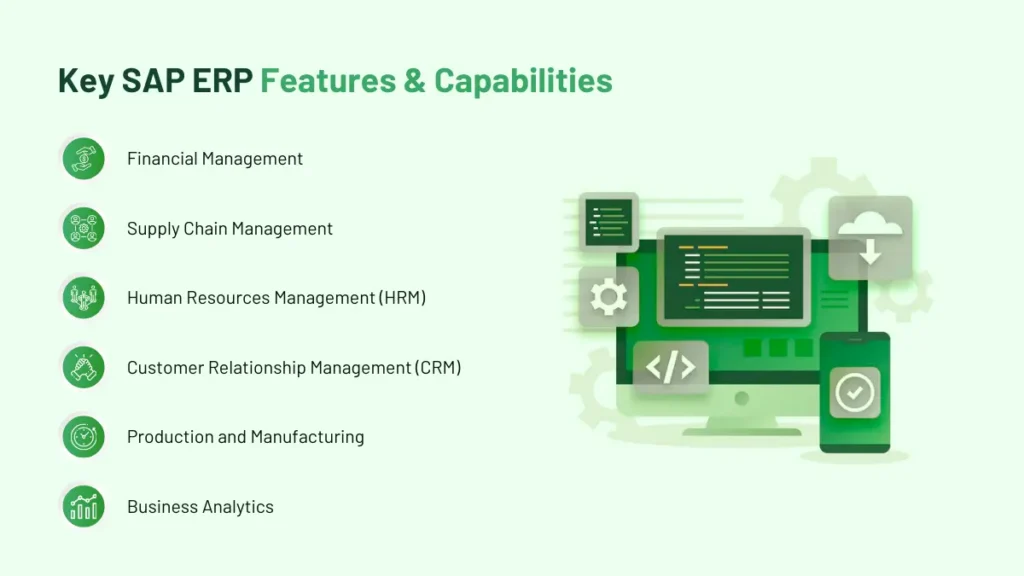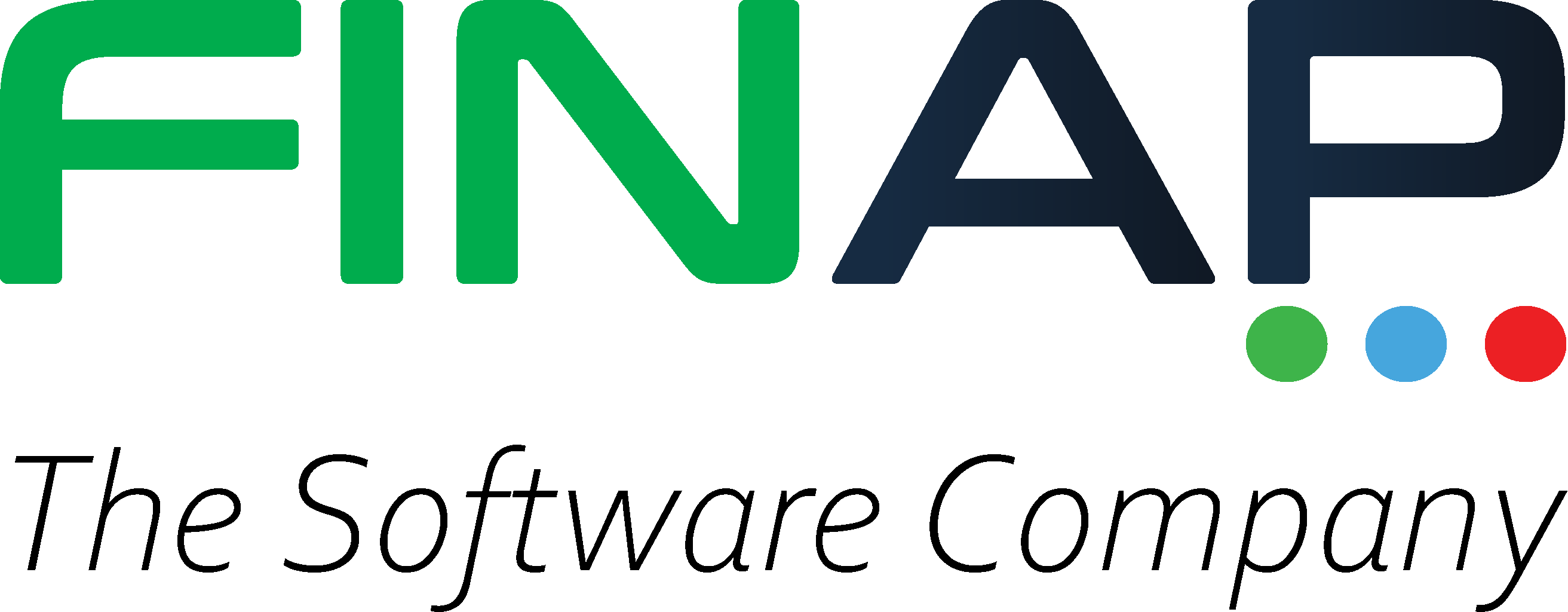1. What is SAP?
SAP, which stands for Systems, Applications, and Products in Data Processing, is a leading provider of enterprise application software. Founded in 1972 in Germany, SAP specializes in creating systems that enable companies to manage business operations and customer relations effectively. SAP software integrates various business processes, providing a unified platform for businesses to operate more efficiently.
2. What is SAP Enterprise Resource Planning (ERP)?
SAP ERP is a comprehensive enterprise resource planning software developed by SAP. It helps organizations integrate key business functions such as finance, sales, production, and human resources into a single system. This integration facilitates better data management, real-time information flow, and streamlined business processes, making it easier for companies to manage their operations.
3. Types of SAP Software
SAP S/4HANA
SAP S/4HANA is SAP’s next-generation business suite designed to help businesses run simple in a digital and networked world. Built on the advanced SAP HANA database, S/4HANA provides real-time analytics and decision-making capabilities, enhancing the efficiency and agility of business operations.
SAP S/4HANA Cloud
SAP S/4HANA Cloud is a cloud-based version of the SAP S/4HANA suite. It offers the same powerful features and capabilities but with the added benefits of cloud computing, such as scalability, flexibility, and reduced total cost of ownership. This solution is ideal for businesses looking to leverage the cloud for their ERP needs.
SAP Business One
SAP Business One is an affordable, easy-to-implement ERP solution designed specifically for small and medium-sized enterprises (SMEs). It covers all core business functions, including accounting, sales, inventory, and customer relationship management (CRM), providing SMEs with a comprehensive tool to manage their operations efficiently.
SAP Business ByDesign
SAP Business ByDesign is a cloud-based ERP solution tailored for mid-sized companies and subsidiaries of large enterprises. It offers end-to-end business processes, real-time insights, and the flexibility to adapt to changing business needs, making it an excellent choice for growing businesses.
4. Key SAP ERP Features & Capabilities

Financial Management
SAP software enhances financial management by streamlining various financial cycles, including bookkeeping, financial reporting, budgeting, and forecasting. It provides accurate and real-time financial data, enabling organizations to better track their financial performance and make informed decisions. Features such as automated reconciliation and integrated financial reporting ensure comprehensive and up-to-date financial insights.
Supply Chain Management
SAP’s Supply Chain Management (SCM) module helps businesses optimize their supply chain operations. It supports effective demand planning, inventory management, procurement, and coordination of operations. With features like real-time tracking and predictive analytics, SAP SCM helps organizations improve efficiency, reduce costs, and respond swiftly to supply chain disruptions.
Human Resources Management (HRM)
The Human Capital Management (HCM) module facilitates the management of various HR functions. It includes tools for payroll processing, employee enrollment, performance management, and talent development. SAP HCM supports organizations in recruiting, retaining, and nurturing their workforce, enhancing overall HR effectiveness.
Customer Relationship Management (CRM)
SAP CRM enables organizations to manage customer relationships more effectively. It includes features for automating sales processes, managing marketing campaigns, and providing excellent customer service. By improving client interactions and maintaining comprehensive customer profiles, SAP CRM enhances customer satisfaction and loyalty.
Production and Manufacturing
SAP’s production planning and manufacturing module helps businesses manage their production processes efficiently. It provides tools for optimizing production schedules, managing resources, and ensuring product quality. SAP’s integrated approach to manufacturing supports better production planning and execution, leading to increased operational efficiency.
Business Analytics
SAP offers robust analytics and reporting tools that allow organizations to gain valuable insights from their data. It provides advanced dashboards, data visualization, and predictive analytics capabilities, enabling data-driven decision-making. SAP’s business analytics tools support strategic planning and performance monitoring by delivering actionable insights.
Business Intelligence
SAP Business Intelligence (BI) tools support effective decision-making by providing comprehensive data analysis and reporting capabilities. These tools help organizations monitor key performance indicators (KPIs), analyze trends, generate detailed reports, enhancing overall business intelligence and strategic planning.
Enterprise Mobility
SAP’s enterprise mobility solutions offer powerful analytics and reporting tools accessible on mobile devices. This enables employees to access real-time data and insights while on the go, improving productivity and decision-making. SAP’s mobile solutions support a more flexible and responsive work environment.
5. Benefits of SAP Software
Efficiency
Time Savings: By automating routine tasks and streamlining processes, SAP software helps employees save time, allowing them to focus on more strategic activities. This increased efficiency translates into higher productivity and faster task completion.
Reduced Errors: Automation minimizes human errors associated with manual processes. Accurate data and automated workflows result in fewer mistakes and higher operational accuracy.
Increased Productivity: With manual tasks reduced, employees can be more productive, leading to greater output and improved business performance.
Cost Savings: Efficiency improvements lead to cost savings by reducing labor hours and optimizing resource utilization. SAP’s streamlined processes help organizations achieve more with fewer resources.
Data Accuracy
Consistency: SAP ensures that data entered into the system is consistent across the organization. This reduces discrepancies and ensures a unified view of information.
Error Reduction: SAP’s built-in validation rules and data integrity checks help minimize data entry errors, resulting in more reliable information.
Timeliness: Real-time data updates ensure that decision-makers have access to the most current information, supporting timely and accurate decision-making.
Better Decision-Making: Accurate and up-to-date data enhances decision-making, enabling organizations to base their decisions on reliable information.
Scalability
Flexibility: SAP solutions are highly adaptable and can grow with an organization’s needs. Whether expanding data volumes, adding users, or increasing business complexity, SAP setups can accommodate these changes.
Cost-Effective Growth: Organizations can scale their SAP infrastructure without investing in entirely new systems. This cost-effective approach supports sustainable growth and long-term success.
Global Reach: SAP’s solutions are suitable for both local and global operations, making them ideal for organizations with an international presence or aspirations.
Competitive Advantage
Responsiveness: SAP’s real-time data and streamlined processes enable organizations to respond quickly to market changes and customer demands. This agility enhances competitiveness and market positioning.
Agility: SAP’s flexible and automated solutions allow organizations to adapt to changing business conditions and seize new opportunities swiftly.
Customer Satisfaction: Improved efficiency and accuracy in managing customer interactions lead to higher customer satisfaction and loyalty.
Innovation: SAP’s advanced analytics and reporting capabilities support innovation by identifying trends, opportunities, and areas for improvement.
Compliance
Regulatory Adherence: SAP provides tools and processes to ensure compliance with industry-specific regulations and standards. This helps organizations meet legal and regulatory requirements.
Auditing Capabilities: SAP’s comprehensive logging and tracking features make it easier to demonstrate compliance during audits, reducing the risk of penalties.
Risk Mitigation: By ensuring accurate and transparent financial and operational data, SAP helps mitigate the risk of non-compliance and associated consequences.
6. Use of SAP in Your Workplace
SAP software can be applied in various areas of your business to drive growth and efficiency. Here is how:
Finance Management
SAP ERP simplifies financial processes, enhances financial reporting, and ensures compliance with accounting standards. It provides real-time insights into financial performance, aiding better financial planning and management.
Supply Chain Management
SAP’s supply chain management capabilities help optimize inventory levels, improve demand forecasting, and enhance supplier collaboration. This leads to cost savings and a better delivery service.
CRM and Customer Experience
SAP’s CRM solutions enable businesses to manage customer interactions more effectively, improve sales processes, and deliver personalized customer experiences, fostering loyalty and satisfaction.
Human Resource Management
With SAP HR solutions, businesses can manage employee data, payroll, and performance more efficiently. These tools also support recruitment, onboarding, and employee development processes.
Project Management
SAP project management tools help in planning, executing, and monitoring projects. They ensure projects are completed on time, within scope, and budget, enhancing overall project success rates.
7. Implementing SAP Software: A Step-by-Step Guide
Successfully implementing SAP software requires careful planning and execution. Here is a refined approach to guide you through the process:
1. Needs Assessment: Begin by thoroughly assessing your business requirements and objectives to determine how SAP software can address them.
2. Strategic Planning: Develop a comprehensive implementation plan that outlines timelines, resource allocation, and key milestones to ensure a smooth transition.
3. Customization: Adapt the SAP software to align with your unique business processes, ensuring it meets your specific operational needs.
4. Data Migration: Efficiently transfer existing data into the new SAP system while maintaining data integrity and accuracy.
5. Employee Training: Provide thorough training for your team to equip them with the skills needed to utilize the new system effectively.
6. System Testing: Perform rigorous testing to validate that the system functions correctly and meets all operational requirements before going live.
7. Go-Live and Monitoring: Launch the SAP software and continuously monitor its performance to address any issues promptly and optimize its functionality.
8. Challenges During SAP Software Implementation
- Complexity
These systems are inherently complex due to their extensive functionality and customization options. Tailoring the system to fit specific business processes often requires specialized expertise and detailed configuration. Navigating through the intricate setup can be daunting and may necessitate additional time and resources to get everything aligned perfectly with your organization’s needs.
- Cost
The financial investment for this software implementation can be substantial. This includes costs for software licenses, hardware infrastructure, consulting fees, and ongoing maintenance. The initial expenditure can be significant, and budget overruns are common, making it essential to plan and manage the financial aspects carefully.
- Change Management
Implementing the software typically involves a major shift in how employees perform their daily tasks. Resistance to change can be a significant barrier, as employees may be accustomed to existing processes and tools. Effective change management strategies are required to facilitate a smooth transition. This includes comprehensive training programs, clear communication about the benefits of the new system, and continuous support to help employees adapt to the new processes.
- Data Migration
Transferring data from legacy systems to this software system can be one of the most challenging aspects of the implementation process. Ensuring that data is accurately migrated while maintaining its integrity requires meticulous planning and execution. This task can be time-consuming, and issues such as data incompatibility, incomplete data, and data corruption need to be addressed to prevent disruptions in business operations.
- Integration
Integrating SAP software with existing systems and third-party applications presents its own set of challenges. Seamless integration is essential for ensuring that different systems work together efficiently and that data flows smoothly across the enterprise. This may involve configuring interfaces, resolving compatibility issues, and ensuring that all systems communicate effectively, which can be complex and require additional technical expertise.
9. FINAP SAP Ready Products
At FINAP, we recognize the transformative power of SAP ERP software and have developed a suite of SAP-ready products tailored to address the unique needs of various industries. These products are designed to seamlessly integrate with SAP solutions.
OMS (Order Management System)
A robust solution designed to streamline and automate the entire order management process, integrating seamlessly with SAP ERP for efficient order handling.
WMS (Warehouse Management System)
An advanced warehouse management solution that optimizes warehouse operations and improves inventory accuracy with real-time visibility and integration with SAP.
FLEX – Truck Booking & Fleet Management Solution
A comprehensive solution for managing truck bookings and fleet operations, offering real-time insights and integration with SAP for enhanced fleet efficiency.
LMD (Last Mile Delivery Solution)
The ultimate last-mile delivery solution tailored for the retail industry, ensuring timely deliveries and optimizing routes with seamless SAP integration.
These SAP-ready products from FINAP are designed to complement and extend the capabilities of your SAP systems. By leveraging these products, businesses can achieve greater operational efficiency, improve customer satisfaction, and drive growth in today’s competitive market.


